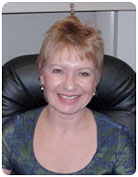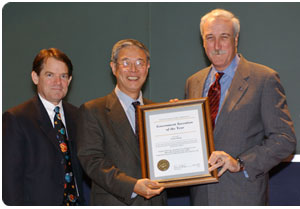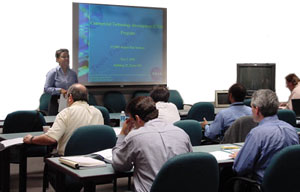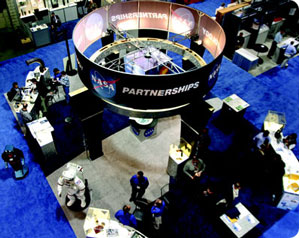 |
| volume 1, number 2 : summer 2003 |
[Download free Acrobat Reader] |
|||||
| Contents: Huang Wins NASA Government Invention of the Year Award Innovators Advance R&D via Commercial Technology Development Program the tech transfer process: Step 1: Scientific/Technical Staff Submit NTR researcher profile: Jeannette B. Benavides Goddard’s Larger Role in Tech Transfer Interest in Goddard Inventions at SAMPE Meeting Tech Transfer Metrics - March 1, 2003 to June 30, 2003 Send Us Your Ideas Submit Your New Technologies |
Huang Wins NASA Government
|
|||||
Innovators Advance R&D via Commercial Technology Development ProgramSince all of the R&D performed at Goddard is intended to further the goals of NASA’s mission, one might wonder how space-program inventions make the transition to other uses. One method to aid that transition is the Commercial Technology Development (CTD) program, which focuses on funding and developing promising technologies that exhibit commercial potential.
The CTD program enables civil servant innovators to develop functional prototypes to make their NASA technologies more compatible with potential commercial applications. Award recipients adhere to aggressive technology development schedules, incorporating commercial industry’s needs. In addition to funding, the Technology Transfer Office offers guidance to aid in the development toward technology transfer. "CTD helped me fund prototypes to prove out ideas; establish commercial importance of my various ideas; … and prepare presentations, Technology Opportunity Sheets, and a Web site to advertise the technology," said John Vranish (Code 544). In addition to further developing technologies for commercial benefits, the CTD program also yields real benefits for NASA. Mr. Vranish calls it reverse technology transfer. "Lessons learned from interacting with industry and helping industry have made the NASA applications better from a technical point of view and have provided industrial suppliers and prototypers with the NASA applications." |
||||||
|
|
||||||
The technology transfer process is started when you-whether a civil servant employee or a contractor serving under a contract, grant, or cooperative agreement-inform us of your innovations through New Technology Reports (NTRs). |
What is an NTR?
An NTR is a detailed disclosure of individual technologies or innovations.
What qualifies as a new technology?
A new technology is broadly defined as any invention, discovery, improvement, or innovation that was either conceived or first reduced to practice in the performance of NASA work. New technologies may occur at the system, subsystem, or component level. New technologies include new or improved techniques, methods, systems, and processes as well as new or improved products, devices, machines, materials, chemical compositions, apparatuses, articles, fixtures, tools, and software.
Why should I submit an NTR?
The NTR allows the Technology Transfer Program to begin looking for commercial applications for the technology and to protect it as intellectual property. Publicly discussing your invention can prevent NASA from securing patent protection and reaping the benefits that can accompany intellectual property protection, so it is important that you submit the NTR first and then check with us before presenting or announcing your innovation. Also, an NTR is required for you to be eligible for a Space Act Award, the Invention of the Year Awards, and other recognition. (More awards information.) Finally, reporting technologies is required of NASA employees and contractors (see NASA Policy Directive 2091.A).
When do I submit an NTR?
An NTR should be submitted as soon as you recognize you have a new invention. This may occur in the middle of a project while R&D is still ongoing, or it may be recognized at the end during normal project reporting. The process of writing programmatic and mission progress reports also may assist you in recognizing and describing a new innovation. The earlier your invention is reported to the Technology Transfer Program, the more effectively and efficiently we can help you find successful commercial partners and market applications.
Most importantly, you should submit the NTR before making any public disclosure of the innovation.
How do I submit an NTR?
Use the online system eNTRe to report new technology. The eNTRe system requires you to describe what motivated the development, the benefits of the technology, and possible commercial applications. The Technology Transfer Program is exploring additional ways to make this process even easier.
Next issue - Step 2: Technology Assessment

researcher profile:
Jeannette B. Benavides
 |
Code 562 Education: B.S, chemistry, University of Costa Rica, 1975 Born: Heredia, Costa Rica |
What invention are you currently working to transfer?
A manufacturing process for single-walled carbon nanotubes (SWCNTs) that uses a helium arc welding process to vaporize an amorphous carbon rod and then form nanotubes by depositing the vapor onto a water-cooled carbon cathode. By avoiding the use of a metal catalyst, the production process is simpler, safer, and much less expensive.
What has the Technology Transfer Program done to introduce your invention to new users?
Program staff have arranged for me to present my technology at many conferences, including SAMPE, the National Design and Engineering Show, and the NASA Medical Technology Summit.
What do you see as the future for your technology?
I’d like my invention to make SWCNTs reach their full potential. They can be used in medicine, microelectronics, scanning force/ tunneling microscopy, materials, and molecular containment.
Any advice for your colleagues?
Don’t forget to submit your NTR. The Technology Transfer Program can really help you a lot, but they can’t do it if they don’t know about your inventions.

Goddard’s Larger Role in Tech Transfer
In covering the June 3rd Potomac Conference of the Greater Washington Board of Trade, The Washington Post noted that "Even though the Washington area is a national leader in federal and university research spending, few of the fruits of that work make it into the private sector." That is why the Technology Transfer Program at Goddard is so important.
"By getting our technologies into the hands of local companies, we can help make the metro-Washington economy resemble that of Boston or Silicon Valley or Seattle," said Nona Cheeks, Chief of Goddard’s Technology Transfer Program. Ms. Cheeks attends meetings such as the Potomac Conference and the Federal Laboratory Consortium for Technology Transfer (FLC) annual conference for new insight into what the Program can do to meet the needs of the many stakeholders involved in tech transfer: the innovators, Goddard, NASA as a whole, the licensing companies, the local and national economies, and the U.S. taxpayers.
Held annually so that top local leaders can discuss major issues facing the region, the Potomac Conference this year focused on transferring federal and university technology, including the cultural and legal barriers to tech transfer and how to create more partnerships between researchers and companies looking to sell and market the technologies.
The FLC national meeting was held May 5-9 in Tucson, Arizona. The theme was "Adding Value to the T2 Frontier." The week included advanced training on intellectual property (IP) management and licensing and sessions on leveraging technologies for economic development.
"The FLC meetings allow us to share best practices with other research labs," said Ms. Cheeks. "Doing so helps all of us to continually improve the technology transfer process and reach the goals of all our stakeholders."

Interest in Goddard Inventions at SAMPE Meeting
|
The annual conference for the Society for the Advancement of Material and Process Engineering (SAMPE) was the ideal staging ground for Goddard technologies to be presented to potential licensees. Held May 11-15 in Long Beach, California, SAMPE 2003 was attended by about 4,300 professionals interested in nanotechnology, wind energy, resin infusion technology and preforms, fire safe materials and infrastructure, and other cutting-edge materials.
|
Three Goddard technologies were featured at the NASA booth:
- Noncatalytic Manufacturing Method for Carbon Nanotubes, Jeannette Benavides (Code 562)
- Multi-Stage Adiabatic Demagnetization Refrigerator and the Passive Gas-Gap Heat Switch, Peter Shirron (Code 552)
- Aluminum Super Polishing Technique, Jim Lyons and John Zaniewski (former NASA employees)
In addition, Dr. Benavides gave a technical briefing regarding her noncatalytic carbon nanotube manufacturing technology. Drawing an audience of about 65, the briefing generated significant interest among attendees. "I came specifically to SAMPE today to hear this talk," said one interested company representative.
In fact, three one-on-one meetings were held with potential licensees, and one license application has already been received.

Tech Transfer Metrics
March 1, 2003 to June 30, 2003
New technologies reported: 40
New technologies were reported by the following civil servants, contractors, and universities:
Civil Servants:Michael Barthelmy (Code 541) |
Contractors:
|
Issued Patents: 3U.S. Patent #6,538,796: MEMS Devices for Spacecraft Thermal Control Applications, Theodore Swanson (Code 545) U.S. Patent #6,566,854: Apparatus for Measuring High-Frequency Currents, John Sutton (Code 564) and Mark Hagmann (contractor) U.S. Patent #6,558,742: Hot-Filament Assisted Methanol-Based Method for Chemical Vapor Deposition of Diamond, Yonhua Tzeng (contractor) Signed Licenses/Partnerships: 5 Gear Bearings, prototyping license to ACS (Advanced CAD/CAM Service Corp.) of Peoria, Illinois Process for Producing High-Quality Optically Polished Surfaces on Bare Aluminum Substrates, licensed to Nu-Tek of Aberdeen, Maryland Process for Producing High-Quality Optically Polished Surfaces on Bare Aluminum Substrates, Space Act Agreement with the University of Arizona in Tucson Regional Applications Center Software: RODIN, licensed to Global Science and Technology of Greenbelt, Maryland The Turbotrap: A Method for Containing a Gas in an Open Container, Space Act Agreement with Global Systems & Technologies, Corp. of Oxon Hill, Maryland |
|

Send Us Your Ideas
We want to do all we can to make it easy and rewarding for you to participate in the Technology Transfer Program. But we need your help. Send us your ideas for program improvements or News articles via email.
![]()

Submit Your New Technologies
You can report new project technologies by submitting the online form on eNTRe.

A publication of
Technology Transfer Program
Mailstop 504
Building 22, Room 290
(301) 286-5810
techtransfer@tco.gsfc.nasa.gov


